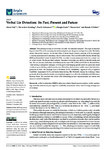Verbal Lie Detection: Its Past, Present and Future
| dc.contributor.author | Vrij, A | |
| dc.contributor.author | Granhag, PA | |
| dc.contributor.author | Ashkenazi, T | |
| dc.contributor.author | Ganis, Giorgio | |
| dc.contributor.author | Leal, S | |
| dc.contributor.author | Fisher, RP | |
| dc.date.accessioned | 2022-12-03T12:27:34Z | |
| dc.date.available | 2022-12-03T12:27:34Z | |
| dc.date.issued | 2022-12-01 | |
| dc.identifier.issn | 2076-3425 | |
| dc.identifier.issn | 2076-3425 | |
| dc.identifier.other | ARTN 1644 | |
| dc.identifier.uri | http://hdl.handle.net/10026.1/20046 | |
| dc.description.abstract |
This article provides an overview of verbal lie detection research. This type of research began in the 1970s with examining the relationship between deception and specific words. We briefly review this initial research. In the late 1980s, Criteria-Based Content Analysis (CBCA) emerged, a veracity assessment tool containing a list of verbal criteria. This was followed by Reality Monitoring (RM) and Scientific Content Analysis (SCAN), two other veracity assessment tools that contain lists of verbal criteria. We discuss their contents, theoretical rationales, and ability to identify truths and lies. We also discuss similarities and differences between CBCA, RM, and SCAN. In the mid 2000s, ‘Interviewing to deception’ emerged, with the goal of developing specific interview protocols aimed at enhancing or eliciting verbal veracity cues. We outline the four most widely researched interview protocols to date: the Strategic Use of Evidence (SUE), Verifiability Approach (VA), Cognitive Credibility Assessment (CCA), and Reality Interviewing (RI). We briefly discuss the working of these protocols, their theoretical rationales and empirical support, as well as the similarities and differences between them. We conclude this article with elaborating on how neuroscientists can inform and improve verbal lie detection. | |
| dc.format.extent | 1644-1644 | |
| dc.format.medium | Electronic | |
| dc.language | en | |
| dc.language.iso | en | |
| dc.publisher | MDPI AG | |
| dc.subject | verbal lie detection | |
| dc.subject | fMRI lie detection | |
| dc.subject | criteria-based content analysis | |
| dc.subject | reality monitoring | |
| dc.subject | scientific content analysis | |
| dc.subject | cognitive credibility assessment | |
| dc.subject | reality interviewing | |
| dc.subject | strategic use of evidence | |
| dc.title | Verbal Lie Detection: Its Past, Present and Future | |
| dc.type | journal-article | |
| dc.type | Journal Article | |
| plymouth.author-url | https://www.webofscience.com/api/gateway?GWVersion=2&SrcApp=PARTNER_APP&SrcAuth=LinksAMR&KeyUT=WOS:000902246000001&DestLinkType=FullRecord&DestApp=ALL_WOS&UsrCustomerID=11bb513d99f797142bcfeffcc58ea008 | |
| plymouth.issue | 12 | |
| plymouth.volume | 12 | |
| plymouth.publication-status | Published online | |
| plymouth.journal | Brain Sciences | |
| dc.identifier.doi | 10.3390/brainsci12121644 | |
| plymouth.organisational-group | /Plymouth | |
| plymouth.organisational-group | /Plymouth/Faculty of Health | |
| plymouth.organisational-group | /Plymouth/Faculty of Health/School of Psychology | |
| plymouth.organisational-group | /Plymouth/REF 2021 Researchers by UoA | |
| plymouth.organisational-group | /Plymouth/REF 2021 Researchers by UoA/UoA04 Psychology, Psychiatry and Neuroscience | |
| plymouth.organisational-group | /Plymouth/REF 2021 Researchers by UoA/UoA04 Psychology, Psychiatry and Neuroscience/UoA04 REF peer reviewers | |
| plymouth.organisational-group | /Plymouth/Research Groups | |
| plymouth.organisational-group | /Plymouth/Research Groups/Centre for Brain, Cognition and Behaviour (CBCB) | |
| plymouth.organisational-group | /Plymouth/Research Groups/Centre for Brain, Cognition and Behaviour (CBCB)/Brain | |
| plymouth.organisational-group | /Plymouth/Users by role | |
| plymouth.organisational-group | /Plymouth/Users by role/Academics | |
| dc.publisher.place | Switzerland | |
| dcterms.dateAccepted | 2022-11-27 | |
| dc.rights.embargodate | 2022-12-9 | |
| dc.identifier.eissn | 2076-3425 | |
| dc.rights.embargoperiod | Not known | |
| rioxxterms.versionofrecord | 10.3390/brainsci12121644 | |
| rioxxterms.licenseref.uri | http://www.rioxx.net/licenses/all-rights-reserved | |
| rioxxterms.type | Journal Article/Review |


